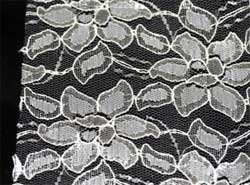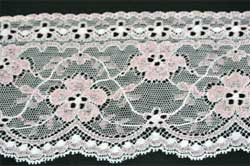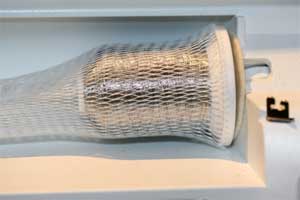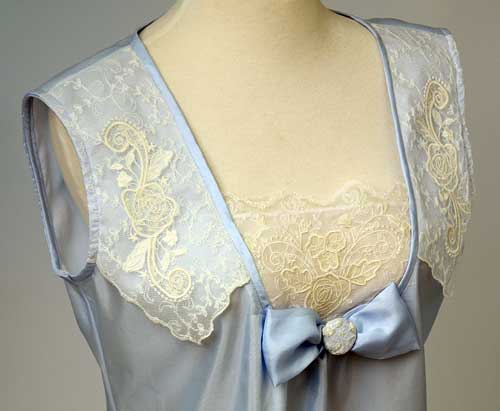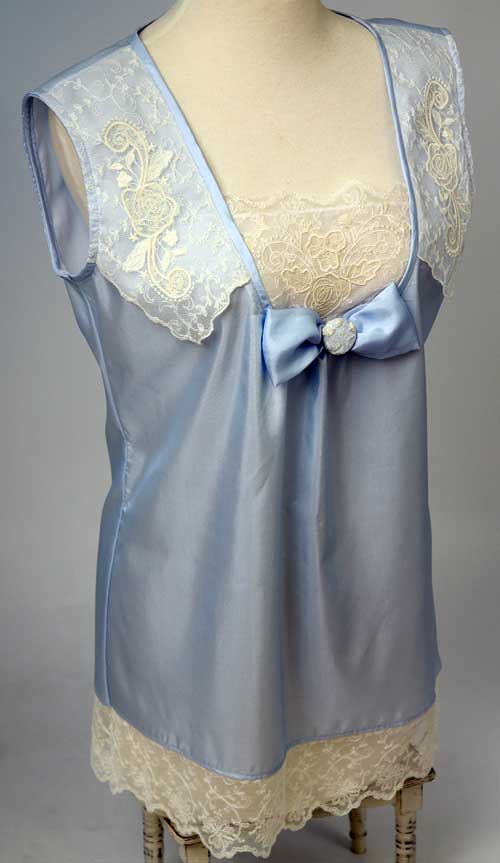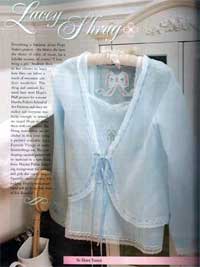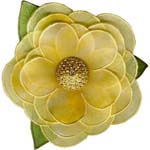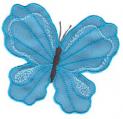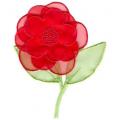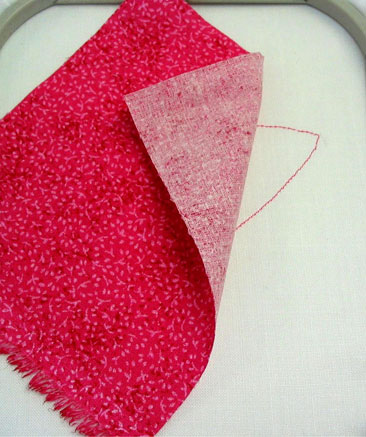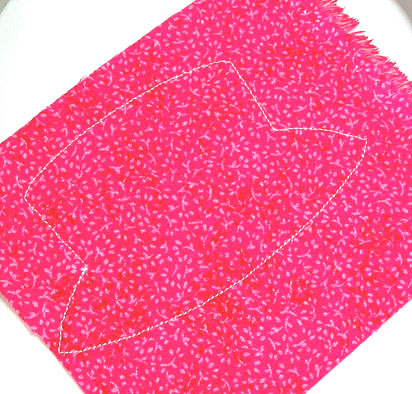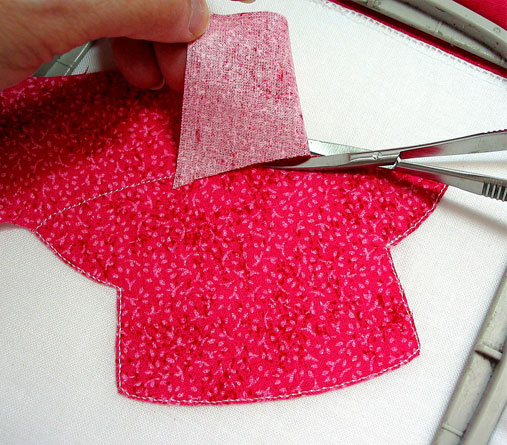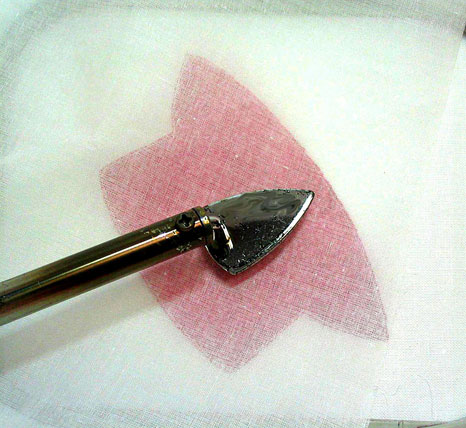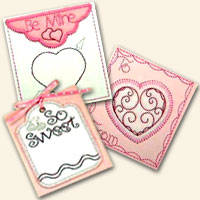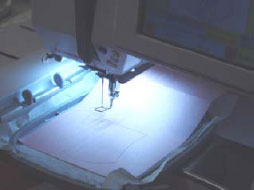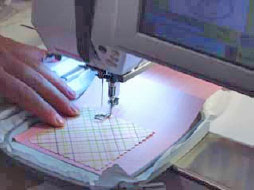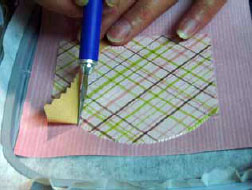Monday, September 7, 2009
Designs for your Machine
| There are three main ways of obtaining embroidery designs.
Pre-Programmed Embroidery Cards Each brand of machine has its own pre-programmed embroidery cards with designs on them. These vary from machine to machine, but for some brands they are as much as $100 each. The designs on these cards are very well tested so you can be sure you get good quality embroidery designs. However they are also very expensive compared to the thousands of designs available online today, and you are limited to the collections released by the brand of machine you use.
Online Embroidery Designs. Over the last 10 years the market has been flooded with thousands of embroidery designs available either free or for purchase from the internet which you can find online. This is great for the embroiderer as you now have access to every kind of design imaginable at very reasonable prices. From the basic filled embroidery design, to freestanding lace, appliqué, redwork and even 3D home decor items and everything in between. If you are entering the popular world of machine embroidery, you will want to ensure you have the right software, hardware and embroidery machine to use designs from the Internet.
You will need the following to be able to use designs from the internet with your embroidery machine.
Digitize Your Own Embroidery Designs Once you are familiar with the many types of embroidery designs available out there, you may want to create your own embroidery designs. You will need digitizing software to be able to do this. Again, each brand of embroidery machine has their own digitizing software, or you can use a generic program like Embird which has many different plug-in programs to enable you to create your own embroidery designs. If you are not using brand specific software to create your design, you will need to convert it from the format it was digitized with, to the embroidery format you need. Embird can convert to most embroidery formats, but there are a few like SHV and ART that you need the specific brand specific software to be able to use the designs with your machine. There are many digitizing tutorials available online to help you learn to digitize in a very easy step by step way. |
Choosing a Machine
| No doubt you will have seen some of the amazing embroidery sewing machines that are available now. Thanks to modern technology - scanning, programming and creative designs can now be a part of everyday home sewing and home embroidery. You don’t have to be a computer whiz to operate these fantastic machines, they are very user-friendly. You can buy embroidery designs on diskettes to go with your machine, or download free embroidery designs from the Internet. To do this you will need to have your computer connected to your sewing machine. Remember that embroidery designs come in different formats for the different brands of machines.
Look into the different brands of embroidery machines available and choose one that suits you best.
Pfaff http://www.pfaff.com Janome/New Home http://www.janome.com Brother http://www.brother.com Husqvarna/Viking http://www.husqvarnaviking.com Bernina http://www.bernina.com Elna/Esante/Babylock http://babylock.com
Allbrands is a handy website with lot of information about the various brands of machines.
The latest versions of each machine, will have the most up to date features, largest sewing fields, and easiest ways to transfer designs from the computer to your machine. If you can afford the latest, then purchase it. But don't worry if you can't as the earlier machines are also great value and will enable you to create amazing projects.
Your time will be well spent initially doing some research on the Internet. You should have some idea of what options you want on your embroidery sewing machine before stepping into a sewing center and putting yourself in the hands on a salesperson. |
| Important things to take into consideration when choosing your machine.
What support is available. Is there a good Sewing Machine dealer in your area that supports your brand of machine? They will be able to help you use the machine, get supplies for it, and also service it.
The sewing field and hoop size. Embroidery designs come in different sizes. If your machine only has a small hoop size, you will be limited to what size design you can sew out. Everyone always wants to sew out the biggest size available. Standard sewing field sizes are 4x4" 5x7", 6x8" and up to 8x12" with some machines. The sewing field is the area inside your hoop where the design is sewn. The physical measurement of your hoop, is different to the sewing field size.
How will you obtain your embroidery designs. Do you need any additional hardware and software to use designs from the internet with your machine? How will you transfer designs from your computer to your machine? More information on the different ways of getting designs can be found here.
The embroidery format your machine uses. Embroidery designs come in different formats for the different brands of machine. You need to ensure the format your brand uses, is commonly available online. If it is not, then you need to check what software you need to convert to this format. The major formats like PES for brother, and HUS for Husqvarna are commonly available. However sometimes machines require a certain version of the format that is not available everywhere, and you may need the software to convert to this. Do your research on this, before you purchase.
Another thing to take into consideration when buying a machine, is the cost of the digitizing software, if you intend to create any designs yourself. Generic programs like Embird Digitizing Studio will enable you to create your own designs. |
| Tips for purchasing a machine from your dealer.
A good sewing machine dealer will be happy to let you try different machines and will show you how they work. You should sit down and play with them until you have a good feel for the machine.
Be comfortable with your machine. The most important aspect of choosing your computerized embroidery sewing machine is how comfortable you feel about its controls and viewing screen. Do you feel confused by it, or does it seem to make sense? Is it easy to get it to do what you want it to do, or does it seem illogical to you? The buttons, layout and procedures of the machine are what you will be dealing with, so make sure they make sense to you.
You should not feel pressured to buy a more expensive model. A good dealer will never try to offer you a special sale price that you have to take immediately or miss out – rather they should offer you the opposite - an extension of a special price so you have time to make up your mind comfortably.
Try before you buy. You should visit your local sewing machine dealers and try a variety of different machines to see what you like. Bring your own thread and your own fabric, of types similar to that with which you plan to do your regular sewing, to try the machines with. Note that some dealers will offer to provide these items for you. You should try your own anyway, as they may provide thread and fabric which the machine handles well, but that you wouldn't actually want to use.
Ask about lessons and courses that the sewing center may offer. Some offer video tapes. Don’t be afraid to ask questions. Ask people who do machine embroidery.
Read the warranty before buying an electronic or computerized sewing machine to see how the manufacturer guarantees the electronics. Many manufacturers warrant the electronics for a shorter period of time than the mechanical parts of the machine.
Be familiar with the hardware requirements. If you want to connect your sewing machine to a computer for doing machine embroidery make sure that it can be connected to your type of computer. For example, some sewing machines do not connect to Macintosh computers, or your laptop may not have the correct port.
Most importantly take into consideration the price of software needed. Dealers will always want to sell you the latest software to go with your machine. While some brands require brand specific software and hardware, others can make do with generic programs like Embird and the Ultimate Box. Do your research before you purchase your machine and it could save you money in the future. |
Basic Care of your Embroidery Sewing Machine
Whether you sew constantly or occasionally, basic maintenance of your machinery is essential. Some models need to be oiled after every 10 hours of use. Always check your manual first. Some of the new machines do not recommend oiling unless it is done by an authorized trained technician.
If your manual recommends oiling, be sure to use proper sewing oil. Oiling not only lubricates the moving parts but also reduces the risk of rust. Refer to your owner’s manual for the right spots to oil. Not every hole needs oil! Some older models have marks to show you where to put the oil. After oiling, do some sewing on scrap material to absorb any excess oil.
Lint and fluff build up and should be removed. Fine working mechanisms such as the bobbin and tensions can be damaged by lint build up. Use a lint-removing brush or vacuum cleaner to remove this regularly. Never use sharp tools to dig out lint.
Treat your machine to a full service regularily by a authorized trained technician. This will keep everything working nicely, and they can get out bits of thread, lint etc that are stuck right inside the workings of the machine and could cause damage, or make it not sew quite as good as it should.
Change your needle regularily. It is reccommended to change it after every 10 hours of sewing, or before you start a new project.
If in doubt, ask the experts. Your embroidery machine is a valuable, and highly computerized piece of delicate technology. If you are not sure about anything with it, always check with an expert first.
Resizing Designs
| Don’t we have a wonderful choice of designs available to us these days, either over the Internet or on embroidery design cards? But how many times have you found the perfect design to realize that it’s not in the size that you want to embroider it? Do you sigh in frustration and look for another design in the size you want or do you have a go at re-sizing the design. Have you tried re-sizing the design and found when you embroidered it out that it was either too dense or had gaps in the design? Okay – the “powers that be” state that when re-sizing designs that the maximum that you should re-size up or down in size is 20%. Beyond that amount the quality of the design isn’t guaranteed. However I have taken designs such as Amazing designs and re-sized them by 100% successfully. It depends entirely on the design itself whether it can be re-sized by a large amount and also a little bit of “insider knowledge” and a correct program for re-sizing. If you do not own a software program specifically for re-sizing then you are really stuck with either re-sizing on your machine – if your machine has this function – or resizing in your machines embroidery software if you own it. Then you really are limited to the 20% increase or decrease in size. Any size beyond that is taking a bit of a risk on the finished result unless you test the design first at your new size. If you resize upwards you risk gaps because as you enlarge the design you are also lengthening the stitches including any satin stitches. As satin stitches are generally already longer stitches, by increasing the size of the design you are also increasing the length of the satin stitches to such a degree that your embroidery software “thinks” that these stitches are actually jump stitches. Then when you view your design in a realistic or 3D view you will see the gaps in the design. The reverse will happen when you decrease the size of a design without re-sizing software. Your stitches will bunch up as you are squashing them into a smaller area. You will now be in the danger of breaking needles when you embroider and we all know what ”fun” that is. The best way to re-size designs – if your embroidery software doesn’t have this function – is to purchase a program that is designed for re-sizing. My favorite (of course) is Embird. In Embird Editor you can take a design and increase or decrease the size of it and also increase or decrease the density if you wish. This means that the stitches will re-calculate if you choose certain settings. There is also the ability to change satin stitches to fill stitches if the length of the satin stitch goes higher than a set size. This means “no more gaps”. Embird also allows you to change the density of just certain parts of your design as well. If you find a design is too dense in one area only then you can separate this part of the design and change the density of just that part. Just a word of warning though – if you currently own Embird and have a design open in Editor and then decide to go into the Density screen for a little “look” just to check it out, make sure when you exit this Density screen that you click on Cancel if you do not want the density in your current design changed. If you are “just looking” in this Density screen with no intention of altering your density in your design on the design page then by clicking OK to exit you are telling Embird that you want your current design to be the same density as their default setting – which is not necessarily the same density as your design. A few people have been fooled by this in the past – VBG I am sure that if you own Embird that you have already discovered that it is an excellent all round editing program as well as being great for re-sizing. For those of you that don’t own Embird then you don’t know what you are missing!! |
Sewing Outlines
Written by Nita O'Keefe from Fancy That Designs This tip is for those of us who sometimes have problems with the outline being off or a part of the design stitching on top of another part. Outlines being off registration are almost always caused by one of two things. Either the hoop got bumped or the design was not properly stabilized. Sometimes it will be due to a poorly digitized design, but more often it will be caused by one of those two things. By poorly digitized I mean that the design has all the fills running in the same direction and no underlay. Many times all the fills will run at the default angle of 45%. This is on the bias of the material and will cause a pull in that direction. Many times an outline will be off because of a thread nest that has occurred. Sometimes it is caused by a broken needle. When you clear away the thread nest and start stitching again, many times the design will have moved a bit due to the pull. It does not take much for the machine to be pulled off track a little bit. Just a tiny bump to the hoop can do this. Then when you start stitching again and realize that the design is stitching over on top of itself and have to stop and pick out stitches, it is very frustrating. I have found that most of the embroidery machines have a forward search feature. All of mine do. The way to cure the above problem is to always stop the machine, turn off the machine and then restart it, forward search to the right place and then start sewing again. This will reset the machine and the design will be back in the proper place. Also if you have one of the machines that has a feature that allows you to combine designs at the machine, you should always use that. Mine has an embroidery edit feature. You can use this to bring the design up in the machine, save it to memory and then if your thread nest or broken needle or any of the other things that can happen do. You can then turn off the machine and let it reset itself, turn the machine back on and bring the design back in from memory. Then it will be at exactly the correct placement and you can forward to the correct spot to start stitching again. This way , you will return to the correct placement even if you have positioned the design differently than it comes up from the card. Other times ,the design will be off due to the hoop getting a little bump during the embroidery process. The same cure works for that too. Reset the machine. Sometimes you will be doing a design on fabric or something large and heavy. This can create a drag that will pull the design off the track too. Find a way to rest the fabric on the table so that is not dragging against the hoop. Happy Stitching Trails! Nita in Texas
Jump Stitches
Digitizing to Reduce Jump Stitches
Written by Hilary and Graham Killerby from African Sewfari
Don’t you just hate loads of jump stitches in a design? I know that there are times they just cannot be avoided, but there are ways around these annoying jump stitches. When using an Automatic program you are at the mercy of the program as far as the elimination of jump stitches is concerned. It all depends on the program you are using as to how successful the result is. However, it is possible to edit out certain jump stitches using an edit program to perfect your design. It is preferable to "manual punch" your design if you wish to minimize the number of jump stitches.
There are two methods we use to achieve the best results.
-
Hiding your traveling stitch lines.
-
Using the removal of overlay stitching which is referred to as "hole sewing" in certain programs.
Hiding Your Traveling Stitch Lines
In the first method, you do exactly what the name suggests - hide your traveling stitch lines between digitized objects of the same color in your design. All traveling stitch lines should be single using the default stitch length (or spacing).
Prior to commencing the digitizing of a design the planning stage is very important. It is invaluable to make a print of the design you want to use in order to plan the route and record the following information:-
-
Initially grade the design objects and number them in order from background objects (i.e. those at the rear of the design in 3D terms), through the intermediate objects to the foreground objects. The objects furthest away must always be digitized first.
-
The colors to be used must be decided on next and if two objects are considered to be equal in 3D value then the lightest colored object must be inserted first.
-
It is always desirable to try and hide lighter colored stitch lines under darker colored objects. Dark thread tends to show through lighter thread colors. It is therefore better to hide the lighter travel stitch lines and leave the darker colored connecting stitches as jump stitches if they cannot all be hidden.
-
Always record the sewing order of the traveling stitch lines on your design print out. Use A,B,C etc. so as not to confuse them with the object numbers. This is necessary as should you wish to change the color or sewing order of an object at a later stage, it will be necessary to edit the relevant traveling stitches as well.
-
When digitizing flowers, digitize the stems last. These can be a tad thicker to cover all the different colored rows of traveling stitches.
-
If you cannot avoid jump stitches, try and make them as LONG as possible so cutting is easy. The face is normally sewn out last and these jump stitches tend to be very tiny and difficult to cut. Try planning the order of digitizing them (eg. right eyebrow, left eye, mouth, left eyebrow, right eye).
HINT: Use a small piece of Solvy to cover the face before stitching. It makes snipping jump stitches far easier.
Removal of Overlay
The removal of overlay method works exceptionally well where one or more object/s are surrounded by another. Some programmers require one entire object to be completely surrounded by another in order to utilize this option while others will work with overlapping objects no matter how little the objects overlap each other.
Planning is once again the essence of success and a print out of the design is essential.
-
In this method the smaller objects are digitized first with the color order once again being done from lightest to darkest with the color of the largest object (cover object) being as dark as possible. This allows the traveling stitches to be hidden successfully.
-
Objects of the same color are linked with traveling stitch lines. The first lines can be placed in the most direct route between objects even if they traverse another color object to be digitized later as they will be hidden.
-
Be careful not to place the darker colored traveling lines too close to already digitized objects as they can end up showing through where the objects and the "cover object" meet.
-
When using this method it is important to increase the "Pull Compensation" factor to +50% of the normal default setting for both the objects and cover object.
Depending of the programmed and the ease of changing the sewing order, use one of the following:-
-
Once all the objects and the cover object have been digitized the cover object must be changed to sew first in order to allow the objects to be accessible for selection when effecting the removal of the overlay.
-
The alternative method is to save the objects and travel stitch lines after they are digitized. Delete them and digitize the cover object, inserting the saved objects on top of the cover object before the removal of overlay is implemented.
Whichever method is used do not forget to change the cover object to sew last in order to hide the travel stitches before saving the finished design.
Digitizing to Reduce Jump Stitches
Written by Hilary and Graham Killerby from African Sewfari
When using an Automatic program you are at the mercy of the program as far as the elimination of jump stitches is concerned. It all depends on the program you are using as to how successful the result is. However, it is possible to edit out certain jump stitches using an edit program to perfect your design. It is preferable to "manual punch" your design if you wish to minimize the number of jump stitches.
There are two methods we use to achieve the best results.
-
Hiding your traveling stitch lines.
-
Using the removal of overlay stitching which is referred to as "hole sewing" in certain programs.
Hiding Your Traveling Stitch Lines
In the first method, you do exactly what the name suggests - hide your traveling stitch lines between digitized objects of the same color in your design. All traveling stitch lines should be single using the default stitch length (or spacing).
Prior to commencing the digitizing of a design the planning stage is very important. It is invaluable to make a print of the design you want to use in order to plan the route and record the following information:-
-
Initially grade the design objects and number them in order from background objects (i.e. those at the rear of the design in 3D terms), through the intermediate objects to the foreground objects. The objects furthest away must always be digitized first.
-
The colors to be used must be decided on next and if two objects are considered to be equal in 3D value then the lightest colored object must be inserted first.
-
It is always desirable to try and hide lighter colored stitch lines under darker colored objects. Dark thread tends to show through lighter thread colors. It is therefore better to hide the lighter travel stitch lines and leave the darker colored connecting stitches as jump stitches if they cannot all be hidden.
-
Always record the sewing order of the traveling stitch lines on your design print out. Use A,B,C etc. so as not to confuse them with the object numbers. This is necessary as should you wish to change the color or sewing order of an object at a later stage, it will be necessary to edit the relevant traveling stitches as well.
-
When digitizing flowers, digitize the stems last. These can be a tad thicker to cover all the different colored rows of traveling stitches.
-
If you cannot avoid jump stitches, try and make them as LONG as possible so cutting is easy. The face is normally sewn out last and these jump stitches tend to be very tiny and difficult to cut. Try planning the order of digitizing them (eg. right eyebrow, left eye, mouth, left eyebrow, right eye).
HINT: Use a small piece of Solvy to cover the face before stitching. It makes snipping jump stitches far easier.
Removal of Overlay
The removal of overlay method works exceptionally well where one or more object/s are surrounded by another. Some programmers require one entire object to be completely surrounded by another in order to utilize this option while others will work with overlapping objects no matter how little the objects overlap each other.
Planning is once again the essence of success and a print out of the design is essential.
-
In this method the smaller objects are digitized first with the color order once again being done from lightest to darkest with the color of the largest object (cover object) being as dark as possible. This allows the traveling stitches to be hidden successfully.
-
Objects of the same color are linked with traveling stitch lines. The first lines can be placed in the most direct route between objects even if they traverse another color object to be digitized later as they will be hidden.
-
Be careful not to place the darker colored traveling lines too close to already digitized objects as they can end up showing through where the objects and the "cover object" meet.
-
When using this method it is important to increase the "Pull Compensation" factor to +50% of the normal default setting for both the objects and cover object.
Depending of the programmed and the ease of changing the sewing order, use one of the following:-
-
Once all the objects and the cover object have been digitized the cover object must be changed to sew first in order to allow the objects to be accessible for selection when effecting the removal of the overlay.
-
The alternative method is to save the objects and travel stitch lines after they are digitized. Delete them and digitize the cover object, inserting the saved objects on top of the cover object before the removal of overlay is implemented.
Whichever method is used do not forget to change the cover object to sew last in order to hide the travel stitches before saving the finished design.
Nashville Lace Denim
| Re-Embroidered Lace
To achieve this hip look, substitute inexpensive lace that you can find in 45" wide in any fabric store. It is an all-over lace that comes in many different colors. Ivory lace & gold metallic threads have been used on the Capri jeans. Pink scalloped lace with silver metallic thread was used on the Jean Jacket. This was a 3" wide trim lace purchased at a sewing market years ago. Experiment with your scraps of lace or fabric to get different looks.
|
Re-Purposed Lace Camisole
|
Re-purpose lace for an “Unforgettable” silk camisole that will turn heads. The ingredients for this blouse include the Nashville Lace embroidery designs that are re-embroidered over lace fabric. Embroidering over a lace foundation fabric, give a romantically elegant look to any project. Click here to view more details on the Secrets Blog. |
|
Fancy Band Sleeve Embellishments
| Fancy Band Sleeve Embellishments Hope has a new magazine article called "Lacey Shrug" that is featured in Issue #117 of Sew Beautiful magazine. This is a two part series that features a lovely shrug pattern that can be worn as lounge wear or as an heirloom blouse. Hope is confident that you will enjoy this new article and may get inspired to use the embroidery designs from Hope's Romantic Hearts & Bows & English Lace Ovals embroidery collections.
The sleeves are embellished with an insertion embroidery design that was created to weave ¼" silk ribbon through. The design is "Insertion2" from the English Lace Ovals collection. Both sleeves will be embroidered in one hooping to save time. Lace has been added to frame the design, giving it a simple elegant look.
|
Make 3D Flowers
How to make your own 3D Flowers. These flower brooches are made from silk organza or cotton organdy. The different sized petals are made in the hoop then stacked together to form a flower. The centers can be anything you choose a beautiful button, unusual beads, bits of fuzzy trim or even a small sparkly pin! Materials You Will Need: Helpful Tips: All the designs fit in a 4x4 hoop. To maximize the number of flower petals you can get from your fabric, do not cut out the flower petals until you have finished making all you wish. Just re-hoop the fabric placing the designs as close together as you can without overlapping. A half-yard of fabric makes a LOT of flower petals! Polyester organza is not recommended for this project as they fray easily. Silk organza has a nice crisp feel and holds the finishing satin stitch edge very well Suggested Tools: Directions for Making the Brooches: Hoop two layers of leaf color fabric or flower color fabric. Stitch the leaf and flower petal designs. You will not need to use stabilizer. Fine cotton thread makes a nice finished edge on cotton fabrics. Rayon or polyester embroidery thread works well on silks. Use the same color and type of thread in your bobbin as your top thread. When you have finished making as many leaf and flower petal parts as you wish carefully cut them out. The little curved snips listed above make this job fast and easy. Cut as close as possible to the edge without cutting through the edging. If you make a mistake and clip the threads, a small drop of Fray Check will fix it. Stack the flower petals in a pleasing arrangement, largest on the bottom, smallest on the top. Tack together with a few small hand stitches on both sides of the center of the flower, but not directly in the middle. Cut or poke a small slit into the very center of the flower petals, going through all of them. Slip your button shank into that hole, pulling it through underneath. Hand stitch the button in place on the back of the flower petals. Place a leaf (or two as desired) over your hand stitching and stitch down following the circle in the center of the leaf design. Place a brooch pin over the stitching, and sew into place securely. Remember to check the placement of the brooch pin before stitching into place so that your flower brooch hangs correctly when pinned on. You may use as many flower petals and/or leaves as desired. The mum and the flower make a very nice flower brooch using six petals, two of each size. Beading in the place of a button makes a lovely center, as do other trimmings such as fringe or looped ribbon. Feathers can be added between the flower layers for more interest. Flower brooches are not just for your lapel -- Back a pair of pretty flowers with shoe clips and wear them on your shoes! Or construct a garden on a pretty straw handbag. Sew some on a linen guest towel using the center design included in the design set. (Complete directions for this method of application are included in the set.) No matter where you put they are sure to bloom! Resources: These directions may not be reproduced, copied or distributed without prior permission from Evy Hawkins at A Bit of Stitch. Thank you. For a printable version of these instructions please click here.
By Evy Hawkins at A Bit of Stitch
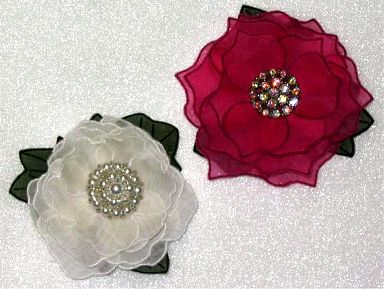
Small curved bladed, very sharp scissors. (The best scissors for this project are from the Scissor Man) Find out how to order here.
www.orientalsilk.com see Mulberry Silk for silk organza
www.thaisilks.com
www.denverfabrics.com
G-Street Fabrics see www.gstreetfabrics.com for locations
| FREE Flower Brooch Design and Instructions |
| FREE Applied Butterfly & Flower The insect wings or flower petals are stitched separately on sheer fabrics and applied to your projects with the body design of each bug, or stem of each flower. |
Make 3D Flowers
How to make your own 3D Flowers. These flower brooches are made from silk organza or cotton organdy. The different sized petals are made in the hoop then stacked together to form a flower. The centers can be anything you choose a beautiful button, unusual beads, bits of fuzzy trim or even a small sparkly pin! Materials You Will Need: Helpful Tips: All the designs fit in a 4x4 hoop. To maximize the number of flower petals you can get from your fabric, do not cut out the flower petals until you have finished making all you wish. Just re-hoop the fabric placing the designs as close together as you can without overlapping. A half-yard of fabric makes a LOT of flower petals! Polyester organza is not recommended for this project as they fray easily. Silk organza has a nice crisp feel and holds the finishing satin stitch edge very well Suggested Tools: Directions for Making the Brooches: Hoop two layers of leaf color fabric or flower color fabric. Stitch the leaf and flower petal designs. You will not need to use stabilizer. Fine cotton thread makes a nice finished edge on cotton fabrics. Rayon or polyester embroidery thread works well on silks. Use the same color and type of thread in your bobbin as your top thread. When you have finished making as many leaf and flower petal parts as you wish carefully cut them out. The little curved snips listed above make this job fast and easy. Cut as close as possible to the edge without cutting through the edging. If you make a mistake and clip the threads, a small drop of Fray Check will fix it. Stack the flower petals in a pleasing arrangement, largest on the bottom, smallest on the top. Tack together with a few small hand stitches on both sides of the center of the flower, but not directly in the middle. Cut or poke a small slit into the very center of the flower petals, going through all of them. Slip your button shank into that hole, pulling it through underneath. Hand stitch the button in place on the back of the flower petals. Place a leaf (or two as desired) over your hand stitching and stitch down following the circle in the center of the leaf design. Place a brooch pin over the stitching, and sew into place securely. Remember to check the placement of the brooch pin before stitching into place so that your flower brooch hangs correctly when pinned on. You may use as many flower petals and/or leaves as desired. The mum and the flower make a very nice flower brooch using six petals, two of each size. Beading in the place of a button makes a lovely center, as do other trimmings such as fringe or looped ribbon. Feathers can be added between the flower layers for more interest. Flower brooches are not just for your lapel -- Back a pair of pretty flowers with shoe clips and wear them on your shoes! Or construct a garden on a pretty straw handbag. Sew some on a linen guest towel using the center design included in the design set. (Complete directions for this method of application are included in the set.) No matter where you put they are sure to bloom! Resources: These directions may not be reproduced, copied or distributed without prior permission from Evy Hawkins at A Bit of Stitch. Thank you. For a printable version of these instructions please click here.
By Evy Hawkins at A Bit of Stitch

Small curved bladed, very sharp scissors. (The best scissors for this project are from the Scissor Man) Find out how to order here.
www.orientalsilk.com see Mulberry Silk for silk organza
www.thaisilks.com
www.denverfabrics.com
G-Street Fabrics see www.gstreetfabrics.com for locations
| FREE Flower Brooch Design and Instructions |
| FREE Applied Butterfly & Flower The insect wings or flower petals are stitched separately on sheer fabrics and applied to your projects with the body design of each bug, or stem of each flower. |
Applique
| The information on this page was supplied by Evy Hawkins from A Bit of Stitch and was previously published in the magazine Flair
Do you have an overflowing fabric stash? Do you have limited time to spend at your embroidery machine? If you answered yes to both these questions, then embroidery machine appliqué is definitely for you!
Because appliqué designs use fabric to cover the majority of the project instead of thread, the stitching time is greatly reduced. Even small pieces of stashed fabrics can be put to good use with appliqué designs. Change the appliqué fabric; stitch the design again and voila! A completely different look can be achieved.
Machine appliqué is very simple. These are the three main steps:
The first step shows you exactly where the appliqué fabric will be placed on the background material. The second step secures the appliqué fabric into position. The third and final step covers the raw edges of the appliqué material with satin stitching, appliquéing the fabric in place.
As with any technique, there is always more than one way to accomplish the goal. Some designers suggest making templates using either a provided template design or the appliqué material stitching outline; cutting out the fabric and then placing the cut-out appliqué into position. Some appliqué designs come with pre-cut fabric pieces to use for the appliqué portions of the design.
In this article we will discuss a very easy method of appliqué that does not require using either pre-cut fabric pieces or templates. |
| Before you begin Applique It is always important to pre-shrink project fabric. It is doubly important to do so when using appliqué designs. Natural fibers (rayon, silk, linen, cotton, wool) all reduce at different rates when washed. Man-made fibers may also reduce, although usually very slightly. If an appliqué fabric reduces more or less than the project fabric underneath it, a wrinkled, puckered appearance will be the result after the first washing. Appliqué designs will look better longer if the appliqué fabric has been adhered to the background material. This is easily accomplished using fusible webbing on the back of the appliqué fabrics. Fused appliqué fabric will not sag or wrinkle. Most fabric intended for appliqué should be backed with fusible webbing, with a few exceptions. Faux fur, vinyl, leather, fleece or any specialty fabric that will melt or crush during contact with heat should not be fused.
A mini-iron may be used to fuse the appliqué fabric directly in the hoop. The fabric should be fused after trimming and before stitching the final appliqué satin stitch edging. Place the hoop on a hard, flat, heat protected surface while doing so. Protect the appliqué fabric with a pressing cloth while ironing. |
| Choosing fabric for your Applique
The sky is truly the limit when choosing fabrics for appliqué. The only fabrics to avoid are those that tend to ravel badly, such as satin faced brocade.* One of the joys of appliqué is that many different choices are available, often within the same piece of printed fabric. Small portions of very large printed fabric work great for little appliqués. Layering sheer fabrics over other material will achieve interesting results. Give a plain cotton fabric a bit of glimmer by laying a piece of sparkle tulle or organza over it. Bold colors will be softened with a layer of chiffon or silk organza.
Thrift stores are great places to find unusual and unique fabrics for appliqué. Garments made from silk and other fine fibers are readily available at rock bottom prices. It doesn’t matter if the garment is un-wearable, the wrong size or just plain ugly! (Not to mention that it’s wonderfully therapeutic to whack up a garment with scissors on purpose!)
Fine leather, vinyl, plastic (such as flannel backed table cloths) fabric paper, wide ribbons and woven trims all make great appliqué fabrics. Don’t forget to check out your linen closet, your closet or even your husband’s closet for inspiration. If you can’t use it, can’t or won’t wear it and it is too good to throw away, give it a new life in an appliqué!
Tip: Fabrics that tend to fray* may still be used with a little special handling. Lay a piece of sheer fabric (such as silk organza or fine tulle) over the fabric when placing the appliqué fabric into position. The overlay fabric will help prevent delicate fibers from fraying later.
Back light colored fabrics with interfacing or white fabric when appliquéing on dark backgrounds. Fuse both layers together with fusible webbing then apply another layer of fusing to be used while ironing the appliqué to the background. This step is also helpful when placing a light colored appliqué over a darker colored appliqué.
The right scissors make appliqué trimming a snap. Use small, very sharp scissors with curved blades. (See resources) |
Step by Step Guide for Sewing an Applique Design.
Follow these step by step directions to complete the free Valentine Hat design and find out for yourself just how fun and easy machine appliqué can be!
To begin:
- Download the free Valentine Hat design from A Bit of Stitch
Valentine Hat Color Chart
- Choose the appliqué fabrics. Back each piece with fusible webbing according to the manufacturer’s directions. Remove the paper backing before beginning.
- Choose the thread colors. (Note: Match the appliqué material, position and satin stitching thread colors to the appliqué fabrics. However, if you find it difficult to see the appliqué position outline stitching, change the thread color for that stitch sequence to a lighter or darker shade for easier trimming.)
- Load the design into the embroidery machine.
- Stabilize the project fabric. Iron-on stabilizer is highly recommended. When stabilizer is adhered to the project fabric, the best results are produced. Iron-on stabilizer is easy to apply and easy to remove. An additional layer of regular tear-away stabilizer may be slipped under the hoop after the hoop is in the machine, if necessary.
- Hoop the stabilized fabric and place the hoop in the machine. This design requires a 4x4 hoop.
- Sew the first stitch sequence, appliqué material. This is the first outline stitching for the hat.
- Place a piece of hat appliqué material over the outline stitching, fused side down. Hold the fabric in place with temporary spray adhesive, if necessary.
- Sew the second stitch sequence, appliqué position. This outline stitching will secure the hat fabric into position on the background fabric.
- Remove the hoop from the machine. Do not remove the fabric from the hoop. Place on a hard flat surface (not your lap!) and carefully trim away the excess appliqué fabric. Trim as close as possible to the stitching. Hold up the excess fabric with one hand while trimming with the other for best results.
- Place the hoop on a hard, flat, heat protected surface and adhere the appliqué fabric to the background fabric using a mini-iron. Protect the appliqué fabric with a press cloth.
- Put the hoop back in the machine and sew the third stitch sequence, appliqué. This is the finishing satin stitch edging around the hat.
- Sew the heart decorations, stitch sequence number four.
- Sew the fifth stitch sequence, appliqué material. This is the first outline stitching for the bow on the hat.
- Place a piece of bow appliqué material over the outline stitching, fused side down. Hold the fabric in place with temporary spray adhesive, if necessary.
- Sew the sixth stitch sequence, appliqué position. This outline stitching will secure the bow fabric into position on the hat.
- Remove the hoop from the machine. Do not remove the fabric from the hoop. Carefully trim away the excess bow fabric.
- Once again, place the hoop on a hard, flat, heat protected surface and adhere the appliqué fabric to the background fabric using a mini-iron. Protect the appliqué fabric with a press cloth.
- Put the hoop back in the machine and sew the seventh stitch sequence, appliqué. This is the finishing satin stitch edging around the bow. Stitch the last stitch sequence, the bow center.
Wasn’t that easy!
Evy Hawkins
Resources:
www.tools-gadgets.com Embroidery Nips (trimming scissors)
www.nancynotions.com Mini Iron & Totally Stable stabilizer
www.sprayandfix.com 505 Spray and Fix Temporary Spray Adhesive
Embroider on Paper
| Embroidering with Paper
Tips: 1. You will need suitable light weight stipple designs to use for the paper embroidery, such as the Valentine Stipple from My Fair Lady as pictured above. 2. Paper of any weight can be used, and any kind of paper can be used - vellum, mulberry paper, handmade paper, etc. In general, the lighter the paper, the better the stitch quality (strange, I know!). Also, cardstock with texture embroiders beautifully. Bazzill paper is my favorite cardstock to use for paper embroidery. To get a good quality stitch on really heavy cardstock, hoop two pieces of tear-away stabilizer. You can also just float a second piece of stabilizer under the design area. This is a great way to use those pieces of stabilizer that are too small to hoop but too big to throw away. 3. Another way to get a better stitch on heavy cardstock is to stitch the design twice before taking the hoop out of the machine. 4. Use the correct needle. A larger needle will create bigger holes in your paper. Smaller needles tend to break easily, so experiment with your paper to find the best size. I almost always use a size 80/12 unless I am embroidering on really heavy cardstock. 5. Stitch a sample! | |
| How to Embroider on Paper | |
|
| 1. Hoop a piece of stabilizer. You can use any kind. I prefer tear-away (the cheap stuff). 2. Get your paper ready. After you have chosen your paper and decided what your finished product will be, cut, score, or fold the paper to the finished size. Decide where you want the embroidery design and how it should be oriented. 3. Unfold the paper, and place it on the hooped stabilizer. You will need to lightly adhere the paper to the stabilizer using small amount of adhesive fabric spray or double-sided tape. Do not hoop the paper! If you use adhesive fabric spray like Sulky KK2000 or 505 spray, use it sparingly, as it can soak through the paper. I prefer double-sided tape. Apply the tape to the back of the paper, then stick the paper to the stabilizer. Try to apply the tape so that it is not in the embroidery area, as it can gum the needle. 4. Gently place the hoop in the machine, and sew the design. 5. Remove paper and stabilizer from the hoop. Cut away the stabilizer close to the design. Although it is tempting to tear the stabilizer away (it is tear-away after all!), don’t do it! You can easily tear your stitches or the paper. |
| How to Applique on Paper | |
|
| Paper appliqué is the same as fabric appliqué! 1. Use the same thread for the first three sequences. Sew the first sequence (the outline of the appliqué). This sequence tells you where to put the appliqué material. 2. Place your appliqué material (paper or fabric) over the outline. You may want to adhere this piece with double-sided tape or fabric adhesive. I like to just hold this piece in place until the first few stitches are sewn. 3. Sew the second sequence (same as the first sequence). This sequence tacks the appliqué material down. 4. Remove the hoop, and cut away the fabric or paper close to the sewn guideline. When using paper as the appliqué material, cut the paper away using an X-Acto knife or other sharp blade. Press hard enough to cut the top layer, but not the bottom layer! If you do cut through to the bottom layer, it will be covered by the stitching. 5. Place the hoop back into your machine and sew the third sequence. This sequence finishes the appliqué. Continue sewing the rest of the design.
Click Here for a pintable version of these instructions in .pdf format. These tips are copyrighted and may not be reproduced without prior permission from My Fair Lady |


